Well, this was a long time coming. It’s been over three years now since I released Why Am I Dead at Sea, which is a bit disheartening considering what I’ve accomplished (or haven’t) since then – but what has been uplifting, and has largely inspired me to write a post mortem for it, is the fact that it’s still reaching new people and being played after being out for this long. Some determined folks even managed to make a complete Russian localization of the game, which required not only translating the entirety of the game’s text, but also decompiling the game and rooting through its underbelly to translate some bits of text that were present in its code files! Wow!
There are so many different aspects of making and releasing the game that I’ve had time to think about and reconsider – what worked, what didn’t, what I’d do differently – that I’ll probably need to split this up into several different posts. Different people will probably also be interested in specific topics, so it makes sense to cut it up.
Disclosure: Every game’s story is different – mine probably more than most – and there are so many variables and unknowns for each game release that I wouldn’t try to turn my experience into a how-to guide (or even a how-not-to guide). What I write should be taken at face-value, and not some sort of larger parable. Later on I’ll probably go into what I might have learned, but this should all be taken with a grain of salt, and an understanding that I’m speaking for myself, not for what I think anyone else ought to do.
With that said, let’s dig into it.
Bird’s Eye View
Let’s start with the basics. Why Am I Dead at Sea is a mystery/adventure game that was released in 2015 for PC/Mac through Steam. I started working on it in early 2013, so it saw a little over two years of development, although there were several breaks in that span for multiple reasons. At that time I wasn’t tracking my development hours very religiously, so unfortunately I don’t have any hard numbers for exactly how long I was working on it when accounting for the breaks. It’s very likely that if I was able to work on the game at a consistent pace all the way through, it would have been in development for a shorter time, but that’s just a hypothetical.
The inception of the game is pretty straightforward, as it was a follow-up to the original flash game Why Am I Dead, which I released in 2012 as a free web game. I didn’t take the game very seriously at all, as I created it mostly to familiarize myself with Flash/AS3, so I was surprised when it received positive attention and interest (and that surprise has been well-documented in this blog). So, after a brief period of trying out other projects that succumbed to scope-creep pretty quickly, I decided it would be a good idea to try my hand at a sequel to the flash game, this time taking it more seriously. My main goal was to jump from making a small freeware game to a premium game – similar to the first, it was mostly meant to be used as a learning experience, although this time I was just upping the stakes and production a bit. My initial timeline was six months – which, obviously, didn’t work out.
I blogged on and off during my development of the game and it has some of its history scattered through different dusty corners of the internet, but the short version of its development is thus: during most of the two year span where the game was in development, I was preparing for, or in the process of, living and working abroad in China as a part-time English teacher. The decision to do this checked off a lot of boxes for me, such as wanting to travel, having extra time to put towards the game – but most importantly, it financially supported me through pretty much all of the game’s development. I returned to America in the fall of 2014, and from that point on I used what little I had saved from that job to house/feed myself through the last stretch of the game’s development, up until the game was released on May 11, 2015.
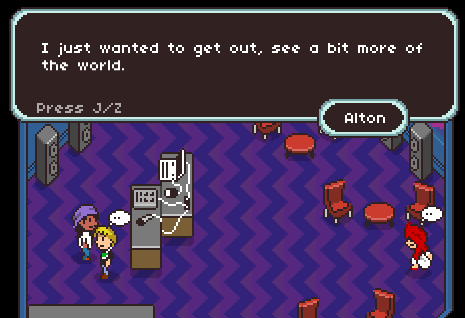
Doing the Dang Thing
That’s the synopsis, but there’s a lot more that could be said about pretty much every step of that period, and why I went the route that I did – but I don’t think it would be controversial to say that this was an, uh, interesting path I took to work on the game – and not one that I would necessarily recommend or use as a model for anything, really. My decision-making was less focused on a larger plan for myself or the game, and more on a short term view of what could help me finish the game. Once I missed my six month timeline and realized just how far off that estimate was, I began to have doubts of whether I would finish the game at all, which became larger and larger over time. Although this wasn’t a game that I felt needed to exist, or that I had some deep personal drive to create, it was still important to me that I finish it, since that was my entire original goal. It’s extremely common to see projects come and go, unfinished and forgotten, and I didn’t want that to happen to me in this case – I felt that if I didn’t finish At Sea, there was no guarantee that I would finish the next project I started, or the one after that, and so on. So, a lot of my motivation was less focused on the game itself and more on my ability to fulfill the commitment I had made in the beginning.
Of course during those 2+ years, a lot changed about me, the game, and my expectations for it – when I thought I would be working on it for six months I obviously expected a lot less from it, and planned to sell it around the price point of $3-5, with really no expectations on its success, or any definition of what success would be, other than completion. The side-effect of it staying in development for so much extra time was that I inevitably grew more attached to it, and despite all my best attempts, I grew emotionally dependent on the game reaching a certain level of success, which I hadn’t really set the game up for in its inception.
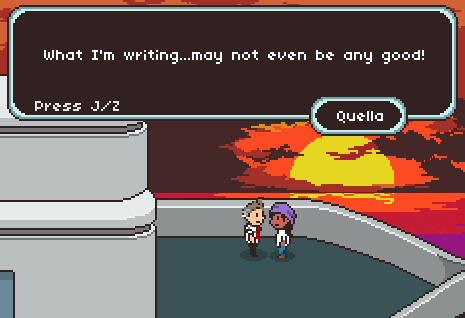
When I returned to America, I devoted all of my time to finishing the game and preparing for its release. This involved going through the (now obsolete) Steam Greenlight system and contacting press about the game, with seriously mixed/underwhelming results. The game ultimately did pass Greenlight, but not because it received the required number of votes – instead, I got the news that it was accepted onto Steam at what seemed like a completely random time. I imagine my game was far from the only one that had this happen, and that Steam was loosening up the requirements of Greenlight to make the way for a self-curating storefront and the current “Steam Direct” system.
No matter the reason, being on Steam was very good news, although by that point it was no longer a guarantee of some baseline amount of sales. And after what felt like an eternity of missed milestones and failed goals, I was finally able to pin down the game’s release date!
So, May 11 rolled around, I hit the big green button, and a nice chunk of my life was released unto the world.
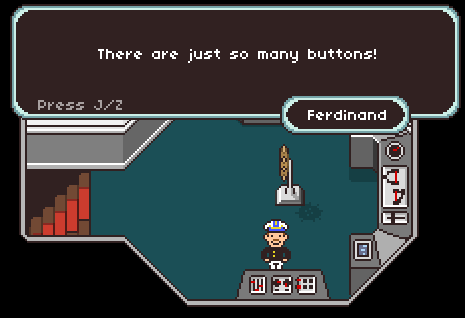
The “Post” Part of the Post-Mortem
So…how was the release? Well, considering how many of the comments/reviews of the game mention it being “unnoticed”, “underrated” or “not well known”, you can probably guess where this is going (or if you used Steamspy you don’t need too much guessing), but let’s put some numbers on it. The game launched at a price point of $9.99, with a 20% discount for the first week, so basically $8. In the first month it just broke $3K in gross revenue, with between 300-400 copies sold. This at least covered what I spent out of pocket to produce the game, so, that’s something. In the next four months it would go on to sell roughly an additional 100 copies, bringing it to $4K.
A bit later on I’ll cover my reaction to the game’s release and reception, but for now I’ll just sum it up as “not good”. But the point I want to make right now is that, counter to all of my expectations at the time, the game’s release was a very tiny piece of the larger picture. The overwhelming majority of the game’s revenue, sales, and general fan reaction or interest came a long time after its release, with comparatively little effort (if any at all) on my part.
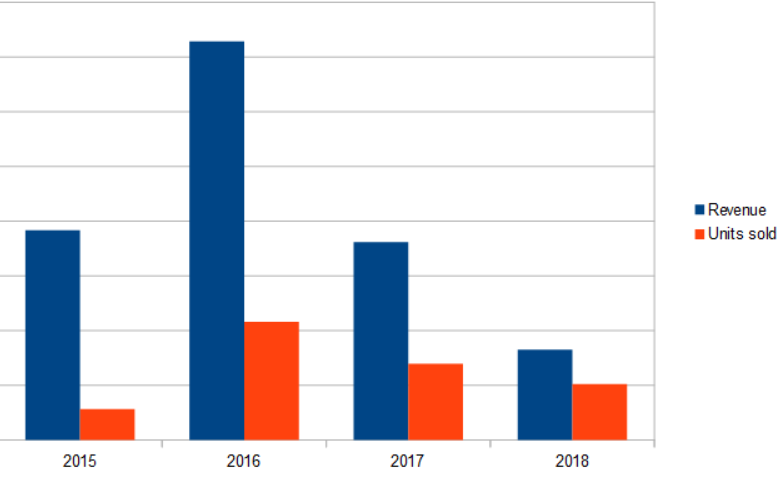 Here is a quick li’l graph of the lifetime sales for the game with the hard numbers removed (I don’t think I’m allowed to disclose those, though I don’t think I’m really that important that I would get in trouble). The game earned nearly twice as much in 2016 as it did in 2015, and only slightly less in 2017. The game was released quite a bit into 2015, but even if we adjust for this, that would mean that the game’s revenue remained constant throughout the next year, and still held up reasonably in 2017. We aren’t finished with 2018, but it’s looking to keep pace with its preceding year as well.
Here is a quick li’l graph of the lifetime sales for the game with the hard numbers removed (I don’t think I’m allowed to disclose those, though I don’t think I’m really that important that I would get in trouble). The game earned nearly twice as much in 2016 as it did in 2015, and only slightly less in 2017. The game was released quite a bit into 2015, but even if we adjust for this, that would mean that the game’s revenue remained constant throughout the next year, and still held up reasonably in 2017. We aren’t finished with 2018, but it’s looking to keep pace with its preceding year as well.
That’s the revenue, but you’ll notice that the units sold increased dramatically more than any change in revenue. A lot of this was due to the game going on deeper and deeper discounts in later sales, but a lot of it was also my decision to cut the game’s base price down to $5 later in 2016. I don’t have the math on hand to prove this, but I believe the price reduction did lose revenue, as the increase in sales wasn’t enough to offset the lowered price.
But my decision to reduce the game’s price had little to do with revenue, and I expected that I probably would lose money this way – my main goal was simply to try and get more people to play the game! And looking at it from that perspective, it wasn’t the worst move. There’s a larger conversation about how we value games and pricing in general that could be had here, but really I just wanted more people to play the damn game.
The delayed nature of the game’s sales can be seen by looking at days of note:
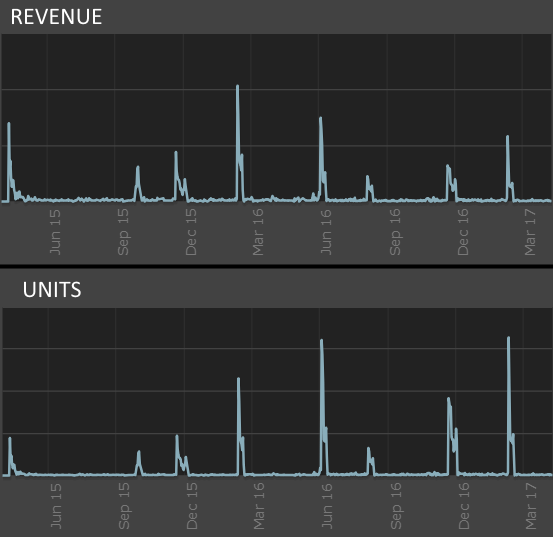
This is a chart of revenue/unit sold for the game up to 2 years after launch. It’s obvious here how sales/discount has impacted the money/unit ratio, but there are some other things I really want to point out – the peak day for revenue was in spring 2016, a full year after launch, and the days for most copies sold are in summer 2016 and spring 2017. The opening day is also only the 3rd highest in this 2-year span, with two periods in 2016 topping it – and even the deeper discount in 2017 gives it a run for its money despite the much lower selling price.
This is the “long tail”, a phrase and concept that I tragically was not fully aware of until after the game’s release – although in this case it looks less like a tail and more like a heart rate monitor, or something. By now, this trend is probably well-documented, but believe it or not almost all of the post-mortems I had access to leading up to my release really focused entirely on the first few months of sales and spoke of nothing else. So, experiencing it firsthand was kind of a surprise. Oh, and that spike in spring 2016 which holds the record for revenue? That was a steam sale that I started completely randomly. There was no particular reasoning or timing behind it; I just scheduled it, and it happened.
To date, the game has sold over 10k copies and grossed over $30k, and it’s still puttering along as new people discover (or circle back to it?) it every day. I could take this moment to compare it to other games and how much less it sold than them, but instead, I’ll compare it to its first several months of sales, the period that I previously thought was indicative of the game’s success. But that ended up only accounting for 4% of units sold and 13% of gross revenue, and those numbers are getting smaller by the day.
So… is this how a sales chart should look? Probably not. Should it look like something else? Maybe? I don’t know. Could it have done better? Or worse? Could I have done things differently? This is entirely too many questions. All I really want to get across is that the game initially did worse than I expected, and then later on, it did better than I expected. My main takeaway is that my expectations are not worth a whole lot, at least not when I’m doing something for the first time!
And none of this is even mentioning how much more player reaction there was after the initial release period. Sure, the game was written about in a bunch of online outlets and got a few reviews, and there were a couple of videos or lets-plays close to launch, but so much of player reviews, word-of-mouth, streams, lets-plays and general fan reaction has been spread out sort of evenly between launch and the present day, usually with spikes around the big sales. To date, the most-viewed video of the game is…a Russian lets-play of the game starting in August 2017. And by far the most thorough, detail-oriented and interesting analysis of the game is an hour and a half long video from early 2017.
Next Up
Well, that was a whole lot of words, way more than I was planning for just an “overview”. But guess what?! There’s still way more I can talk about! For this post I tried to keep it a bit tidy and informational for those who really just want the facts, but later on I plan to descend deep into self-indulgent rambling about my feelings and personal take-aways from the game.

I think you did a good job on the game but I’m biased. I’m glad it turned out to be more successful than you originally thought. I think there’s an important lesson in there, somewhere…